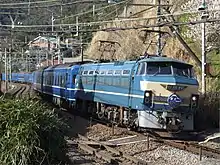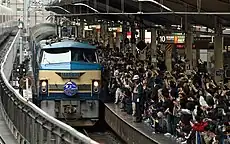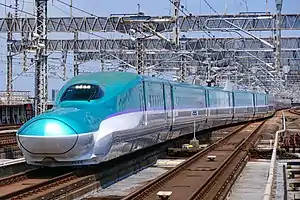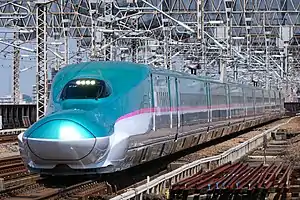 E5 series shinkansen on a Hayabusa service, March 2011 | |
| Overview | |
|---|---|
| Service type | Shinkansen |
| Locale | Honshu/Hokkaido, Japan |
| Predecessor | Hayate |
| First service | 1 October 1958 (Limited express) 5 March 2011 (Shinkansen) |
| Current operator(s) | |
| Former operator(s) | JNR JR West JR Central JR Kyushu |
| Route | |
| Termini | Tokyo Shin-Hakodate-Hokuto Sapporo (From 2031) |
| Distance travelled | 823.8 km (511.9 mi) |
| Line(s) used | Tōhoku Shinkansen, Hokkaido Shinkansen |
| On-board services | |
| Class(es) | Standard + Green + Gran Class |
| Catering facilities | Trolley service |
| Technical | |
| Rolling stock | E5 series, H5 series |
| Track gauge | 1,435 mm (4 ft 8+1⁄2 in) standard gauge |
| Electrification | 25 kV 50 Hz AC (overhead line) |
| Operating speed | 320 km/h (200 mph) (Tōhoku Shinkansen), 260 km/h (160 mph) (Hokkaido Shinkansen) |
The Hayabusa (はやぶさ, "Peregrine falcon") is a high-speed Shinkansen service operated by East Japan Railway Company (JR East) and Hokkaido Railway Company (JR Hokkaido) between Tokyo and Shin-Hakodate-Hokuto in Japan since 26 March 2016.[1] The name was formerly used for a limited express sleeping car service operated by JR Kyushu, which ran from Tokyo to Kumamoto, and was discontinued in March 2009.
Service pattern
Hayabusa trains stop at Tōkyō, Ueno*, Ōmiya, Sendai, Furukawa*, Kurikoma-Kōgen*, Ichinoseki*, Mizusawa-Esashi*, Kitakami*, Shin-Hanamaki*, Morioka, Iwate-Numakunai*, Ninohe*, Hachinohe*, Shichinohe-Towada*, Shin-Aomori, Okutsugaru-Imabetsu*, Kikonai*, and Shin-Hakodate-Hokuto station.[2] Additionally, some Hayabusa services begin or end at Shin-Aomori Station.
(*) Not served by all trains
Most Hayabusa trains are coupled to an Akita Shinkansen Komachi train between Tokyo and Morioka.
The fastest service from Tokyo to Shin-Hakodate-Hokuto station takes approximately 3 hours 57 minutes.[2]
Train formation
Hayabusa services are normally operated by 10-car E5 series or H5 series trainsets, with car 1 at the Tokyo end. All seats are reserved and non-smoking.[2]
| Car No. | 1 | 2 | 3 | 4 | 5 | 6 | 7 | 8 | 9 | 10 |
|---|---|---|---|---|---|---|---|---|---|---|
| Class | Standard | Standard | Standard | Standard | Standard | Standard | Standard | Standard | Green Car | GranClass |
| Facilities | Wheelchair space | Wheelchair space |
Hayabusa trains feature premium GranClass accommodation with 2+1 leather seating and complimentary food and drinks, including alcohol.[3]
In 2021, payphones were removed from cars 3 and 5.
History
Sleeping car service (1958–2009)

The Hayabusa service commenced on 1 October 1958, operating between Tokyo and Kagoshima.[4] From 20 July 1960, the train was upgraded with 20 series sleeping cars, and extended to run to and from Nishi-Kagoshima (now Kagoshima-Chūō).[4] From 9 March 1975, the train was upgraded with 24 series sleeping cars.[4]
Dining car service was discontinued from March 1993.[5]
From 4 December 1999, the Hayabusa was combined with the Sakura service between Tokyo and Tosu.[6]
From 1 March 2005, the Hayabusa was combined with the Fuji service between Tokyo and Moji, following the discontinuation of the Sakura service which previously operated in conjunction with the Hayabusa.

Finally, due to declining ridership, the Hayabusa, along with its counterpart service, the Fuji, was discontinued from the start of the revised timetable on 14 March 2009.[5]
Shinkansen service (2011–)
From 5 March 2011, the Hayabusa name was revived for the new 300 km/h shinkansen services operated by JR East between Tokyo and Shin-Aomori using new E5 series trainsets,[1] and extended to Shin-Hakodate-Hokuto Station on 26 March 2016.
Rolling stock
Sleeping car service
In its final days, the limited express train was formed of 14 series sleeping cars based at JR Kyushu's Kumamoto Depot, typically consisting of six cars in the Hayabusa portion and six cars in the Fuji portion. The train was hauled by a JR West EF66 electric locomotive between Tokyo and Shimonoseki, a JR Kyushu EF81-400 electric locomotive between Shimonoseki and Moji (through the undersea Kanmon Tunnel), and by a JR Kyushu ED76 electric locomotive from Moji to Kumamoto.[7]
 ED76 on a Hayabusa service, March 2010
ED76 on a Hayabusa service, March 2010 14 series coach at rear of Hayabusa service, March 2010
14 series coach at rear of Hayabusa service, March 2010
Locomotive types used
Shinkansen service

The new shinkansen Hayabusa services use 10-car E5 series sets, which initially operated at a maximum speed of 300 km/h (185 mp/h) between Utsunomiya and Morioka.[1] The maximum speed was raised to 320 km/h (200 mp/h) from the start of the revised timetable on 16 March 2013.[8] From the same date, some services run coupled to E6 series Super Komachi services between Tokyo and Morioka. These services were limited to a maximum speed of 300 km/h.[8] Since 15 March 2014, the name of Super Komachi services was returned simply to Komachi, and the maximum speed has been raised to 320 km/h; from the same date, some Hayabusa services are operated by 10-car E5 series sets coupled to 7-car E6 series sets. At Morioka, the E5 series and E6 series sets decouple, with the E5 series set continuing along the Tohoku Shinkansen as the Hayabusa and the E6 series set turning onto the Akita Shinkansen as the Komachi.
From 26 March 2016, with the opening of the Hokkaido Shinkansen from Shin-Aomori to Shin-Hakodate-Hokuto, the Hayabusa name was used for services operating between Tokyo, Sendai, and Shin-Hakodate-Hokuto.[9] From the start of the 26 March 2016 timetable revision, ten return services operate daily between Tokyo and Shin-Hakodate-Hokuto, and one return service daily operates between Sendai and Shin-Hakodate-Hokuto.[10]
See also
References
- 1 2 3 東北新幹線 「はやぶさ」 3月5日 デビュー! [Tohoku Shinkansen "Hayabusa" 5 March debut] (PDF) (in Japanese). JR East. 11 November 2010. Retrieved 11 November 2010.
- 1 2 3 JR時刻表 [JR Timetable] (in Japanese). Japan: Kotsu Shimbunsha. 2016. EAN 4910053110464.
- ↑ "Japan Rail Pass - Use Japan Rail Pass on Hayabusa". Jrpass.com. Retrieved 31 July 2015.
- 1 2 3 4 5 6 7 さらば九州ブルートレイン [Farewell Kyushu Blue Trains]. Tokyo: Ikaros Publications Ltd. April 2009. p. 99. ISBN 978-4-86320-168-2.
- 1 2 "寝台特急"富士"・"はやぶさ"ものがたり" [The Story of the "Fuji" and "Hayabusa" Sleeping Car Limited Expresses]. Railfan Magazine. Vol. 49, no. 575. March 2009. pp. 22–35.
- ↑ 列車名鑑1995 [Train Name Directory 1995]. Japan: Railway Journal. August 1995.
- ↑ JR新幹線&特急列車ファイル [JR Shinkansen & Limited Express Train File]. Japan: Kōtsū Shimbun. 2008. ISBN 978-4-330-00608-6.
- 1 2 "320-km/h Hayabusa matches world speed record". The Japan Times. Japan: The Japan Times Ltd. 17 March 2013. Retrieved 11 September 2013.
- ↑ 北海道新幹線の列車名決定について [Details of Hokkaido Shinkansen train names] (PDF). News release (in Japanese). Japan: Hokkaido Railway Company. 20 November 2014. Retrieved 20 November 2014.
- ↑ 北海道新幹線 新青森~新函館北斗間開業に伴う運行計画の概要について [Details of operations following opening of Hokkaido Shinkansen between Sendai and Shin-Hakodate-Hokuto] (PDF). News release (in Japanese). Japan: East Japan Railway Company. 16 September 2015. Retrieved 16 September 2015.
External links
- Official JR East site for E5 series Hayabusa (in Japanese)



